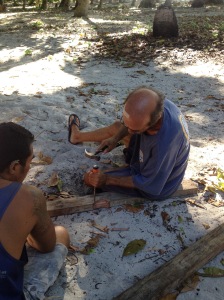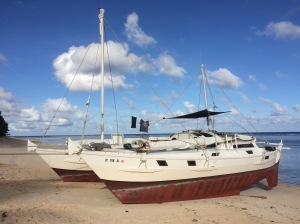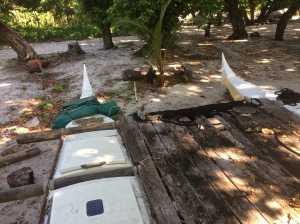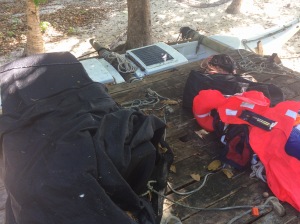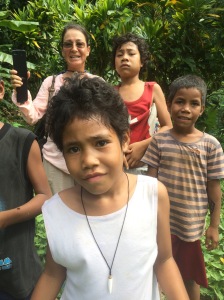It was a bittersweet homecoming aboard Aluna at the Helena Marina in Sorong. Sorong is the capital of Indonesia’s West Papua province, situated at just shy of one degree South of the Equator. I did have to cry a couple of silent tears, as I had dearly hoped never having to see our Aluna in that same state of abandonment I had seen so many other boats along our journey to the remote corners of the Pacific. Those boats that languish in muted suffering at the far end of piers of remote harbors or anchored out on a rusty chain under flapping pieces of disintegrating tarp amongst other local relics in a bay just slightly off the charts. Those boats that had lost the care of a watchful owner willing to squeeze the needed elbow grease onto the decks and below, where swift tropical deterioration tickles any bank account not fit enough to stand the test of time.
The grey green of monsoonal moisture had laid itself heavily over Aluna’s shrouds and more of it along the hull sides. Dark grey soot from the nearby charcoal factory had encrusted itself on the cockpit cover whose plastic windows had been replaced with little signs of love and care. On opening the galley hatch a stench of moldy mess made itself known as the one predominant intruder who clearly had decided to make itself at home and keep any benevolent spirit a good distance away.
Now eighteen days later, days of equatorial sweat and buzzing sandflies, days of selective reanimation strategies, days of simple down to earth baking soda scrubbing and vinegar spraying, days of lightening the ship onto a growing rubbish pile ashore, testimony to my years of hoarding materials to remedy any imaginable situation out in the isles past the end of Western goods supply chains, days of cleansing the tired sails of the hundreds of mud wasp nests, but also days of thinking how to best prepare Aluna for another stretch of undefined length, during which she will be eagerly waiting for her new masters, stemming my fickle will heavily against the tide of careless abandonment.
Our fourth attempt at finding a good caretaker to inspire Aluna with new life had once again failed. My good friend Christoph had come all the way from Switzerland to find out first hand if Aluna could be fit to serve as a vessel to provide his rapidly growing boys with a maritime adventure of the superior kind before being absorbed into the tentacles of educational stress and inflicted social aspiration. Unfortunately, he turned out to be unable to muster up enough manhood to counteract the sprouting fears running amok in his nicotine infused imagination. Strangely enough, against my own lingering fears, Aluna’s enchantment did work wonders in his soul, he pronounced all kinds of enchantments about what a fine and spacious ship she could be. But alas not enough of it to live up to the only right decision: look one’s fears into the eyes and say yes to all the uncertainties of an adventure about to be born, and give vivid testimony to the stern fact, that this is the only life form truly worth living!
Anther quick chapter of modern humanity just no longer being fit enough for the basic requirements of life closed therefore rather quickly and Christoph’s journey ended instead amongst the hordes of tourists grazing the wonders of Raja Ampat, where snorkeling humanoids soothe themselves in what might be the last healthy coral reefs of the planet.
On the upside of things after barely one week of work Aluna’s splendid offer of a cozy and rather comfortable home on the water, where you can live independently, fully immersed in the spirit of adventure, the cruising ground of Southeast Asia spread out before you, became immediately apparent and for a short while I settled back into this sweet life of laying out a day’s work after waking up with the sun and the chanting birds, fix a hearty breakfast with tropical fruits and then get at it. Doing practical things while the mind rolls round and round, finding its way out of the self-imposed labyrinths, unstuck emotions lingering way past their deadlines, contemplating the crude absurdity of egotistic world views and capitalist colonization, being fully aware if I would be able to continue for a month or two more, Aluna would be slicing the waves again and sail away towards the horizon, where wonders wait in the whereabouts of watery worlds caressed by winds of monsoonal moisture…
Tomorrow morning quite some time before dawn I will sneak out of Aluna’s comfy quarters, making one last round to check that everything is left properly so as not to suffer too much by the absence of a caretaking eye and make my way through the muddy road towards the airport/ There I will begin the arduous two day journey back home, knowing quite well that with Aluna now out of the water with her ‘vital organs’ protected from sun and rain with a sturdy tarp, she will wait patiently but persistently insisting that a new owner is wanted, somebody with enough lust for adventure to make her shine again.
After having inspected her health in person I now have a better understanding of her condition and we have accordingly adjusted the sales price to reflect the work that needs to be done and the money to be spent to bring her back up to the strident specs of ocean voyaging. The list of what needs to be done is hanging on our wall and can be requested by any interested party. Most if not all of it can be done where she lies now, either by a willing new occupant on site or remotely by instructing the capable workers at the yard for what are very reasonable fees. Plus: You’ll be starting your journey in the magic area of Raja Ampat, premier dive location of SE Asia!
If interested, please do get in touch!











 My mission was tight and well defined: to transform those to sailing novices into trustworthy sea people worthy of that name, to make sure they will be able and willing to take charge of the trusty vessel that had been our home for a good nine years and brought us from one end of the vast Pacific to the other. We have crisscrossed Moreton Bay in Southeast Queensland, to the South of the outflow of the Brisbane River, always visible from afar with the giant horse-like cranes of the container port. The weather has been kind enough to provide us with a good array of different sailing conditions, from hot, dead calms to breezy 25 knot winds, where the two apprentices experienced the crucial threshold where the big mainsail has to come down in a hurry and then one continues to claw one’s way upwind with the number two main. We have anchored in a crowded weekend anchorage and also in a river with tidal flows. Little by little their initial clumsiness has given way to a hint of new modalities ready to grow in efficiency. They do have a long stretch ahead of them with nature’s dangerous game awaiting them out there in the wide blue yonder.
My mission was tight and well defined: to transform those to sailing novices into trustworthy sea people worthy of that name, to make sure they will be able and willing to take charge of the trusty vessel that had been our home for a good nine years and brought us from one end of the vast Pacific to the other. We have crisscrossed Moreton Bay in Southeast Queensland, to the South of the outflow of the Brisbane River, always visible from afar with the giant horse-like cranes of the container port. The weather has been kind enough to provide us with a good array of different sailing conditions, from hot, dead calms to breezy 25 knot winds, where the two apprentices experienced the crucial threshold where the big mainsail has to come down in a hurry and then one continues to claw one’s way upwind with the number two main. We have anchored in a crowded weekend anchorage and also in a river with tidal flows. Little by little their initial clumsiness has given way to a hint of new modalities ready to grow in efficiency. They do have a long stretch ahead of them with nature’s dangerous game awaiting them out there in the wide blue yonder.










